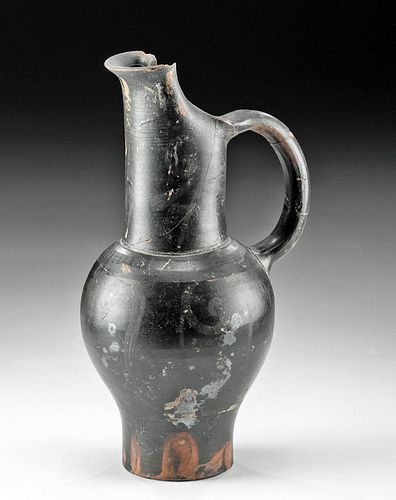Etruscan Pottery Beaked Oinochoe - Phantom Group
Lot 33
About Seller
Artemis Gallery
686 S Taylor Ave, Ste 106
Louisville, CO 80027
United States
Selling antiquities, ancient and ethnographic art online since 1993, Artemis Gallery specializes in Classical Antiquities (Egyptian, Greek, Roman, Near Eastern), Asian, Pre-Columbian, African / Tribal / Oceanographic art. Our extensive inventory includes pottery, stone, metal, wood, glass and textil...Read more
Categories
Estimate:
$1,200 - $1,800
Absentee vs Live bid
Two ways to bid:
- Leave a max absentee bid and the platform will bid on your behalf up to your maximum bid during the live auction.
- Bid live during the auction and your bids will be submitted real-time to the auctioneer.
Bid Increments
| Price | Bid Increment |
|---|---|
| $0 | $25 |
| $300 | $50 |
| $1,000 | $100 |
| $2,000 | $250 |
| $5,000 | $500 |
| $10,000 | $1,000 |
| $20,000 | $2,500 |
| $50,000 | $5,000 |
| $100,000 | $10,000 |
| $200,000 | $20,000 |
About Auction
By Artemis Gallery
Oct 21, 2021
Set Reminder
2021-10-21 10:00:00
2021-10-21 10:00:00
America/New_York
Bidsquare
Bidsquare : Fall Antiquities & Ethnographic Art Auction
https://www.bidsquare.com/auctions/artemis-gallery/fall-antiquities-ethnographic-art-auction-7725
Ancient art from Egypt, Greece, Italy and the Near East, as well as Asian, Fossils, Pre-Columbian, Native American, African / Tribal / Oceanic, Fine art, and much more! All categories, all price ranges... all legally acquired and guaranteed to be as described or your money back. Artemis Gallery info@artemisgallery.com
Ancient art from Egypt, Greece, Italy and the Near East, as well as Asian, Fossils, Pre-Columbian, Native American, African / Tribal / Oceanic, Fine art, and much more! All categories, all price ranges... all legally acquired and guaranteed to be as described or your money back. Artemis Gallery info@artemisgallery.com
- Lot Description
Classical World, northern/central Italy, Etruria, Etruscan culture, attributed to the Phantom Group, ca. 4th century BCE. An intriguing, wheel-thrown pottery oinochoe of a tall and attractive form exhibiting an annular foot, an inverted piriform body, a cylindrical neck with a 'beaked' pouring spout, and a handle joining rim to shoulder, all covered in lustrous black glaze. The obverse of the body and neck are adorned with spiraling tendrils, groups of petite frets, a ladder-form collar around the neck, and the silhouette of a standing figure in the center, all once presented with fugitive pigment. The areas where the fugitive pigment has worn away creates a faint, almost ghostly appearance - hence the designation as being part of the Phantom (also Fantasma) Group. An attractive and haunting example of ancient Etruscan pottery! Size: 4.4" Diameter x 9.3" H (11.2 cm x 23.6 cm)
Cf. The Metropolitan Museum of Art, accession number 91.1.450
Provenance: ex-Millea Brothers Ltd, Boonton, New Jersey, USA; ex-private New York, USA collection; ex-Parke Bernet Galleries, February 14-15, 1964, lot #234
All items legal to buy/sell under U.S. Statute covering cultural patrimony Code 2600, CHAPTER 14, and are guaranteed to be as described or your money back.
A Certificate of Authenticity will accompany all winning bids.
PLEASE NOTE: Due to recent increases of shipments being seized by Australian & German customs (even for items with pre-UNESCO provenance), we will no longer ship most antiquities and ancient Chinese art to Australia & Germany. For categories of items that are acceptable to ship to Australia or Germany, please contact us directly or work with your local customs brokerage firm.
Display stands not described as included/custom in the item description are for photography purposes only and will not be included with the item upon shipping.
#167325Repaired from approximately 8 to 10 large pieces, with small chips and light adhesive residue along break lines. Abrasions and nicks to pouring spout, handle, body, and foot, with wear to areas of black glaze primarily around foot, and chipping and fading to fugitive pigment across composition. Great preservation to overall form. The 'phantom' pigment outlines are still visible and relatively clear. Scattered areas of silvery iridescence on black-glazed areas.Condition
- Shipping Info
-
All shipping is handled in-house for your convenience. Your invoice from Artemis Gallery will include shipping calculation instructions. If in doubt, please inquire BEFORE bidding for estimated shipping costs for individual items.
-
- Buyer's Premium



 EUR
EUR CAD
CAD AUD
AUD GBP
GBP MXN
MXN HKD
HKD CNY
CNY MYR
MYR SEK
SEK SGD
SGD CHF
CHF THB
THB














